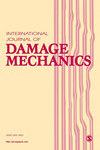含气煤在装卸路径中的破坏与渗透性
IF 3.9
2区 工程技术
Q2 MATERIALS SCIENCE, MULTIDISCIPLINARY
引用次数: 0
摘要
为了有效地预防动态气体灾害,在室内和数值模拟试验中研究了添加垂直和卸载径向应力。研究的目的是确定不同的气体压力和加载速率是如何影响渗透率和损伤变形的。结果表明:含气煤以剪切破坏为主,加载速率的提高使渗透率突变变慢,在屈服点、峰值点和峰后稳定点塑性应变逐渐减小;同时,气体压力的升高使试样从压缩状态向膨胀状态的过渡提前,渗透率提高,并使特定点的塑性应变升高。在此基础上,重点研究了中尺度破坏和渗透率特征。破坏过程中,煤体内部渗流通道由垂直方向逐渐转变为不规则变形。建立了以能量消耗为中心的损伤模型,表明损伤演化曲线随垂直应变呈“S”形。同时,较高的轴向加载速率延迟了不稳定裂纹扩展的开始,而提高气体压力则加快了试件的损伤速度。研究结论对减轻煤岩动力灾害具有重要的现实意义。本文章由计算机程序翻译,如有差异,请以英文原文为准。
Damage and permeability of gassy coal in loading – Unloading path
To effectively prevent dynamic gas disasters, the adding vertical and unloading radial stress were investigated in laboratory and numerical simulation experiments. The objective about the research was to ascertain how various gas pressures and loading rates affected permeability and damage deformation. The results conclude that shear failure predominates in gassy coal, a rise in loading rate causes the permeability to mutate more slowly, and the plastic strain gradually decreases at the yield, peak, and post-peak stable points in gassy coal. As well, a rise in gas pressure causes an earlier transition from compression to expansion state of specimens, enhances permeability, and rises the plastic strain at specified points. Furthermore, the study focuses on the meso-scale failure and permeability characteristics. During failure, the seepage channel within the coal body gradually transitions from a vertical orientation to irregular deformation. In addition, a damage model is formulated centered around energy consumption, demonstrating that damage evolution curves exhibit an ‘ S’ shape with vertical strain. Meanwhile, higher axial loading rates delay the onset of unstable crack propagation, but raising gas pressure quickens the pace of damage to specimens. The conclusions of this research hold significant practical implications for mitigating coal-rock gas dynamic disasters.
求助全文
通过发布文献求助,成功后即可免费获取论文全文。
去求助
来源期刊

International Journal of Damage Mechanics
工程技术-材料科学:综合
CiteScore
8.70
自引率
26.20%
发文量
48
审稿时长
5.4 months
期刊介绍:
Featuring original, peer-reviewed papers by leading specialists from around the world, the International Journal of Damage Mechanics covers new developments in the science and engineering of fracture and damage mechanics.
Devoted to the prompt publication of original papers reporting the results of experimental or theoretical work on any aspect of research in the mechanics of fracture and damage assessment, the journal provides an effective mechanism to disseminate information not only within the research community but also between the reseach laboratory and industrial design department.
The journal also promotes and contributes to development of the concept of damage mechanics. This journal is a member of the Committee on Publication Ethics (COPE).
 求助内容:
求助内容: 应助结果提醒方式:
应助结果提醒方式:


